by Alison Mitchell, Co-Executive Director, New Jersey Conservation Foundation
Walk into nearly any grocery store, any time of year, and you’ll likely find fresh blueberries in the produce aisle. Many consider them a perfect fruit … sweet and juicy, delicious fresh or cooked, and packed with health-boosting antioxidants.
If you’re among the many who love blueberries, you have a New Jersey woman to thank!
Over a century ago, agricultural pioneer Elizabeth Coleman White successfully “tamed” wild blueberries growing in the New Jersey Pine Barrens to create the nation’s first cultivated blueberry. In doing so, she launched what has become an international industry producing about a billion pounds a year.
March is Women’s History Month, a great time to applaud White’s accomplishment – which is especially amazing considering that most women of her time were discouraged from working outside the home.
White was born in 1871 in New Lisbon, the oldest daughter of cranberry grower Joseph J. White and his wife, Mary Fenwick White. Many of the family’s cranberry bogs had been passed down from Mary’s father, James A. Fenwick, who in the mid-1800s bought significant land in Burlington County for cranberry farming.
The only one of the four White sisters to take an interest in the family business, Elizabeth shared a love of the natural world and agriculture with her father. She graduated from a Quaker school in Philadelphia and took courses at the Drexel Institute of Art, Science and Industry (now Drexel University), but was self-taught in botany.
She began working at Whitesbog, the family farm, at age 22, helping to supervise the cranberry pickers. “I always shirked the woman’s job of serving meals and instead stuck close to my father’s side, eager to hear all the cranberry talk,” she later recalled.
Elizabeth often wondered if the wild blueberries – also known as “swamp huckleberries” – growing between cranberry bogs could be cultivated to create a second crop for the farm. The conventional wisdom was that they couldn’t.
Blueberries had always grown wild in the acidic soils of the Pine Barrens, but their quality was inconsistent – some were sour, while others were small and not fleshy. Most local farmers believed wild bushes couldn’t be domesticated to produce the consistently sweet and plump berries needed for a commercial crop.
In 1910, Elizabeth learned of Dr. Frederick Coville, a U.S. Department of Agriculture botanist who had done extensive blueberry research but had been unable to cultivate good berry-producing bushes in a greenhouse. After reading his publication, “Experiments in Blueberry Culture,” Elizabeth convinced her father to invite Coville to Whitesbog to partner with them on an experimental blueberry plot.
Colville accepted, and they began their experiments. Elizabeth recruited local “Pineys” to scour the Pine Barrens in summer for bushes that produced superior berries. Over a period of five years, at least 100 different bushes were identified, dug up and cut into grafts that produced hundreds of other plants that could be cross-pollinated.
The collaboration turned out to be fruitful! In 1914, they picked their first cultivated berries, and by 1916 the first commercial crop was for sale.
Coville trumpeted their achievement in the June 1916 edition of National Geographic, in an article titled, “The Wild Blueberry Tamed: The New Industry of the Pine Barrens of New Jersey.” He noted that because blueberries grow best in soils “so acid as to be considered worthless for other agricultural purposes,” their cultivation provides local farmers a new crop for previously unused land.
Elizabeth went on to help establish the New Jersey Blueberry Cooperative Association, which found creative ways to market the cultivated blueberries.
Later in life, she put her knowledge of cultivation to use producing holly trees and other plants, and became the first female member of the American Cranberry Association. For her contributions to the agricultural industry, she was the first woman to receive a citation from the New Jersey Department of Agriculture.
All hail Elizabeth Coleman White, nicknamed “The Blueberry Queen of the Pine Barrens!” To celebrate Women’s History Month, enjoy some delicious blueberries and remember the determined woman who helped make them possible. (Unfortunately, New Jersey blueberries – our official state fruit – won’t be ready until summer.)
Another way to honor Elizabeth Coleman White is to visit Whitesbog Historic Village, located within Brendan T. Byrne State Forest. The nonprofit Whitesbog Preservation Trust maintains Whitesbog’s buildings and trails, hosts special tours and events, and keeps the farm’s fascinating history alive. To learn more about Whitesbog, go to https://whitesbog.org/.
And for information about preserving New Jersey’s land and natural resources, visit the New Jersey Conservation Foundation website at www.njconservation.org or contact me at [email protected].


